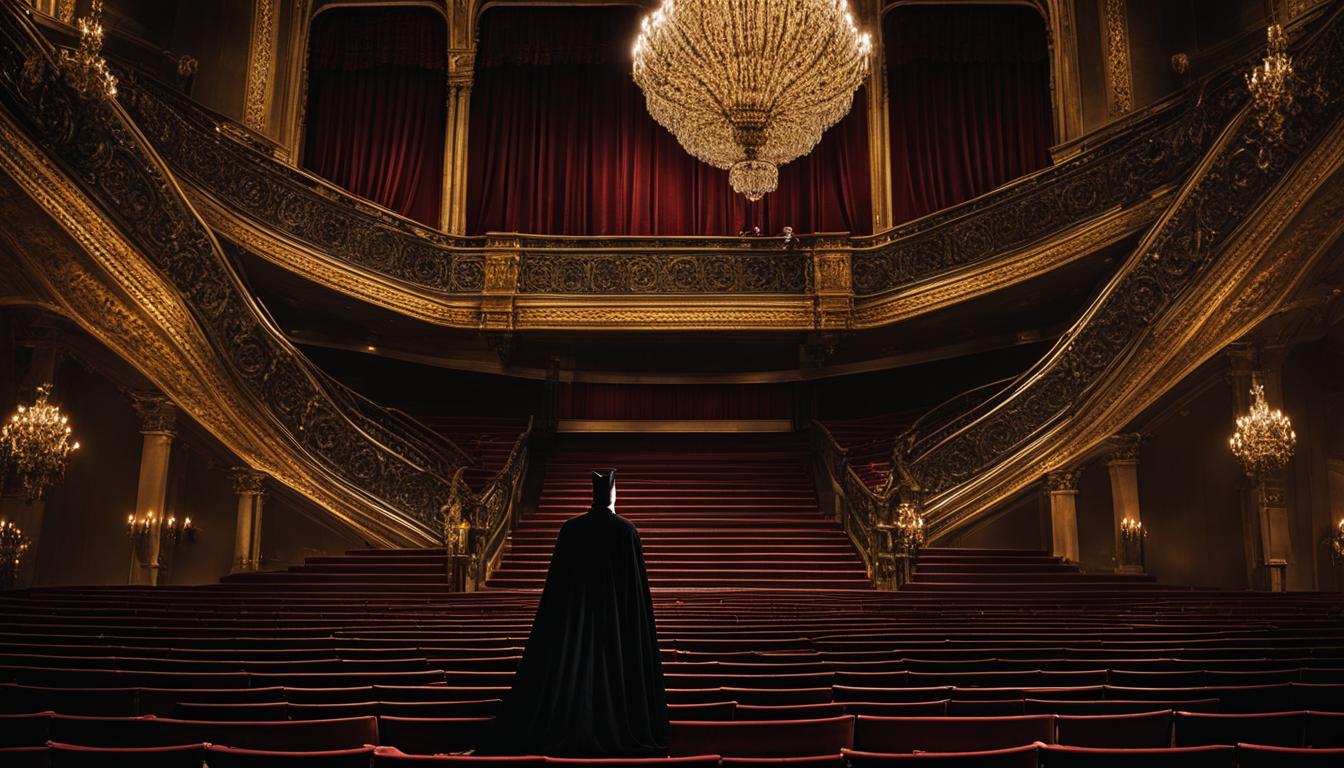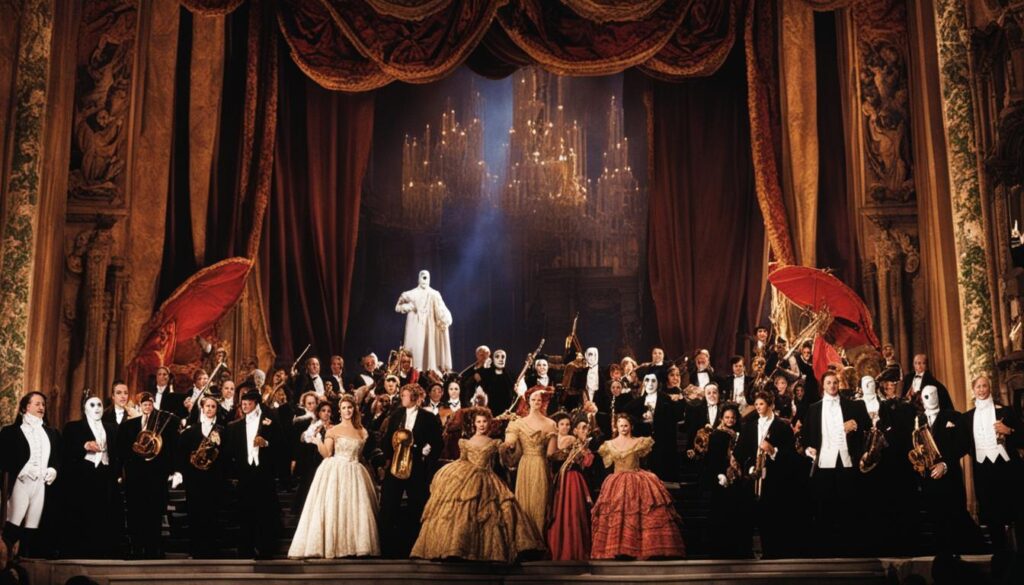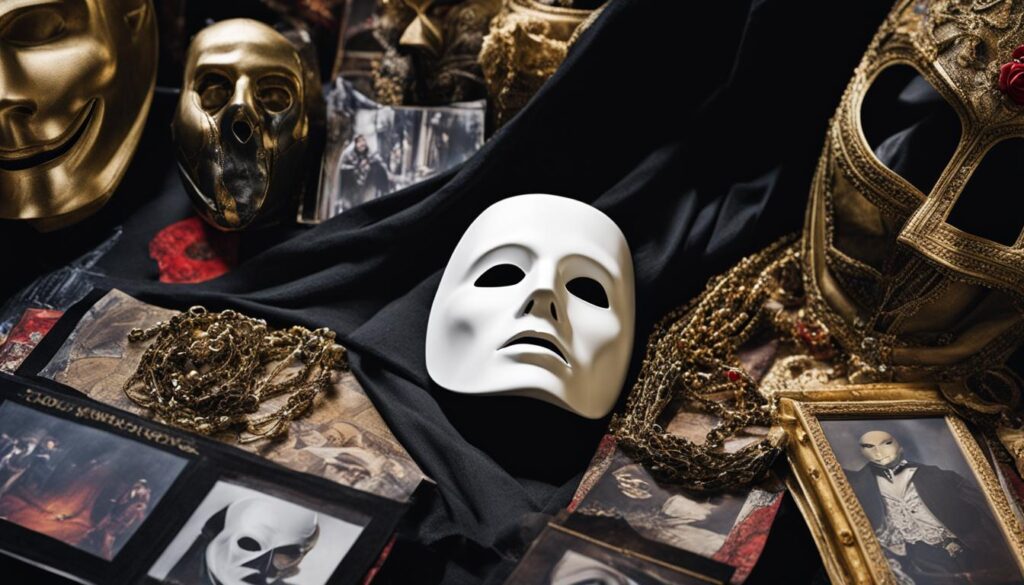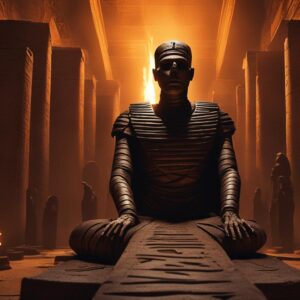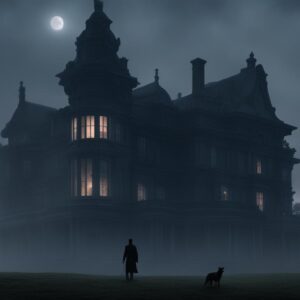Greetings! Today, I would like to take you on a journey back in time to experience the magic of The Phantom of the Opera (1962), a classic horror film that has enthralled audiences for decades. This gothic masterpiece, produced by Hammer Films, tells a tragic love story that will leave you captivated till the very end.
Starring Michael Gough and Herbert Lom, this film explores themes of obsession, unmasking, and the destructive power of love. It is a true testament to the art of storytelling and has even inspired the unforgettable Andrew Lloyd Webber musical adaptation that we know today.
Key Takeaways:
- The Phantom of the Opera (1962) is a classic horror film produced by Hammer Films.
- The film is a gothic horror adaptation of Gaston Leroux’s novel.
- It tells the tragic love story of a disfigured composer who falls in love with a young soprano.
- The film explores themes of obsession, unmasking, and the destructive power of love.
- The Phantom of the Opera (1962) has influenced subsequent adaptations, including Andrew Lloyd Webber’s famous stage musical.
The Origins of The Phantom of the Opera
Before delving into Hammer Films’ take on The Phantom of the Opera, it’s essential to trace the origins of this iconic story. The tale of the Phantom has been adapted multiple times throughout history, captivating audiences with its themes of love, obsession, and tragedy. The earliest adaptations can be traced back to Universal Pictures, which released two versions of The Phantom of the Opera in the past. The first was in 1925, starring the legendary Lon Chaney Sr., and the second in 1943, featuring Claude Rains. Both adaptations were based on Gaston Leroux’s novel and followed the story of a disfigured composer haunting an opera house.
The Origins of The Phantom of the Opera
The 1962 version by Hammer Films takes a different approach, placing the story in a London opera house and infusing it with their trademark Gothic flair. The studio’s unique interpretation adds depth and atmosphere to the narrative, enriching the viewing experience for horror enthusiasts. The Phantom of the Opera’s enduring appeal and ability to transcend time and mediums are a testament to the universal resonation of this captivating story.
To get a better understanding of the impact of Hammer Films’ take on The Phantom of the Opera, it is important to explore the critical reception and legacy of this adaptation. Despite initial mixed reviews and disappointing box office performance, the film has gained a cult following over the years. Hammer Films’ influence in the horror genre and their ability to infuse classic stories with gothic elements have solidified The Phantom of the Opera’s place in cinematic history. The 1962 film provided a foundation for subsequent adaptations, including Andrew Lloyd Webber’s iconic stage musical, which has further popularized the timeless tale.
Hammer Films’ Take on The Phantom of the Opera
Hammer Films, known for its luxurious Gothic style, took on the challenge of adapting The Phantom of the Opera in 1962. The film was directed by Terence Fisher, a seasoned horror director, and starred Herbert Lom as the Phantom. However, despite the talent involved, the film received a disappointing reception upon release. It was criticized for being too vague and slow, lacking the punch and horror expected from a Hammer production. The romantic elements also overshadowed the horror, turning it into more of a romantic fable than a terrifying Gothic tale.
Despite its disappointing reception, Hammer Films’ take on The Phantom of the Opera offers a unique perspective on the timeless tale. The film’s Gothic visuals and lavish production design create a haunting atmosphere that transports viewers to the eerie world of the London opera house. The performances, particularly Herbert Lom’s portrayal of the disfigured Phantom, add depth and emotion to the story. While the film may not have achieved immediate success, it showcases Hammer Films’ signature style and serves as a testament to their bold approach to classic horror stories.
“Hammer Films’ adaptation of The Phantom of the Opera turns the tale into more of a romantic fable than a terrifying Gothic tale. The film’s slow pace and lack of horror elements may disappoint horror enthusiasts, but it still offers a visually striking and emotionally engaging experience.” – Horror Gazette
Hammer Films’ Influence on the Horror Genre
Despite the disappointing reception of The Phantom of the Opera (1962), Hammer Films has had a significant impact on the horror genre. The studio’s lush Gothic style and atmospheric visuals have become synonymous with classic horror cinema. Hammer Films’ productions introduced a new level of sophistication and artistry to the genre, influencing future filmmakers and leaving a lasting legacy. While The Phantom of the Opera may not be hailed as one of the studio’s most successful films, its contribution to the genre cannot be overlooked.
| Pros | Cons |
|---|---|
| – Luxurious Gothic style | – Disappointing reception |
| – Herbert Lom’s compelling performance as the Phantom | – Lack of horror elements |
| – Visually striking production design | – Slow pace |
| – Unique take on the iconic story | – Romantic elements overshadow the horror |
The Plot of The Phantom of the Opera (1962)
The Phantom of the Opera (1962) tells the captivating story of Professor Petrie, a struggling musician who sells his music, including a complete Joan of Arc opera, to Lord Ambrose D’Arcy. However, D’Arcy double-crosses Petrie and plans to present the music as his own. Devastated by this betrayal, Petrie transforms into the disfigured Phantom and seeks revenge on D’Arcy for stealing his work.
Meanwhile, Harry Hunter, a theatrical producer, becomes enamored with Christine, a talented young soprano who becomes the target of the Phantom’s obsession. As the Phantom’s obsession intensifies, Christine finds herself trapped in a web of danger and intrigue.
The film delves into themes of betrayal, vengeance, and the destructive power of unrequited love. It takes audiences on a thrilling and emotional journey through the dark corners of the London opera house, where secrets and tragedy unfold.
Table: Main Characters of The Phantom of the Opera (1962)
| Character | Actor |
|---|---|
| Professor Petrie | Edward de Souza |
| Lord Ambrose D’Arcy | Michael Gough |
| Harry Hunter | Thorley Walters |
| Christine | Heather Sears |
The Phantom of the Opera (1962) weaves a mesmerizing tale of love, betrayal, and tragic obsession. As the story unfolds, audiences are drawn into a world of intrigue and suspense, where the boundaries between good and evil become blurred. The film’s gripping plot, combined with the atmospheric setting of the London opera house, creates a truly haunting experience for viewers.
With its memorable characters and compelling narrative, The Phantom of the Opera (1962) stands as a testament to the enduring power of this timeless story. It explores the depths of human emotion, showcasing the destructive consequences of unrequited love and the lengths some will go to seek revenge.
The Cast of The Phantom of the Opera (1962)
The Phantom of the Opera (1962) features a talented cast that brings the iconic characters to life. In the role of the Phantom, we have Herbert Lom, who delivers a haunting performance. His deep voice and commanding presence add to the eerie atmosphere of the film. Michael Gough portrays the villainous Lord Ambrose D’Arcy, providing a strong and memorable antagonist. Edward de Souza takes on the role of the heroic producer Harry Hunter, bringing authenticity and depth to the character. And finally, we have Heather Sears as the young soprano Christine, capturing the vulnerability and strength of the character.
Each member of the cast delivers compelling performances, adding layers of complexity to their respective roles. Herbert Lom’s portrayal of the Phantom showcases the character’s torment and longing, making him both sympathetic and fearsome. Michael Gough’s Lord Ambrose D’Arcy exudes a sense of entitlement and menace, creating the perfect foil for the Phantom. Edward de Souza’s Harry Hunter brings a sense of integrity and valor to his character, providing a source of stability amidst the chaos. And Heather Sears’ Christine embodies both innocence and determination, making her a captivating presence on screen.
The chemistry between the cast members is palpable, enhancing the emotional depth of the story. They navigate the complex dynamics of love, obsession, and betrayal with skill and nuance. The performances of Herbert Lom, Michael Gough, Edward de Souza, and Heather Sears contribute to the enduring appeal of The Phantom of the Opera (1962), making it a standout entry in the Hammer Films repertoire.
Note: The image shows the main cast of The Phantom of the Opera (1962) in an iconic scene from the film.
The Visuals of The Phantom of the Opera (1962)
The visual elements of The Phantom of the Opera (1962) contribute to its eerie and atmospheric tone. Hammer Films’ renowned art and costume team creates a lush and gothic aesthetic that immerses viewers in the world of the film. The film also features a replica of the Paris Opera House set, adding to the authenticity of the setting. Additionally, the mask design by Roy Ashton, with its gray, featureless full covering, allows only one eye to peer through, adding to the Phantom’s mysterious and haunting appearance.
| Visual Element | Description |
|---|---|
| Art and Costume Design | The Hammer art and costume team meticulously crafted a gothic aesthetic, using elaborate sets, ornate costumes, and atmospheric lighting to create a visually captivating world for the film. |
| Paris Opera House Set | The film features a replica of the iconic Paris Opera House set, bringing an air of authenticity to the setting and transporting viewers to the grandeur of the opera house. |
| Mask Design | Roy Ashton’s mask design for the Phantom is both eerie and iconic. The gray, featureless full covering obscures the Phantom’s disfigured face, leaving only one eye exposed and adding to his enigmatic and haunting presence. |
The combination of these visual elements in The Phantom of the Opera (1962) creates a visually stunning and immersive experience for audiences. The art and costume design transport viewers to a world of gothic beauty and darkness, while the replica Paris Opera House set adds a sense of authenticity to the film’s setting. The mask design by Roy Ashton adds to the mysterious and haunting presence of the Phantom, leaving a lasting impression on viewers.
“The visual elements of The Phantom of the Opera (1962) contribute to its eerie and atmospheric tone. Hammer Films’ renowned art and costume team creates a lush and gothic aesthetic that immerses viewers in the world of the film.” – Film Critic
The Music of The Phantom of the Opera (1962)
The music in The Phantom of the Opera (1962) plays a significant role in setting the atmosphere and capturing the essence of the story. The film features an original score by Edwin Astley, which includes the opera that plays a central role in the plot. The passionate opera presentation, inspired by Joan of Arc, adds to the dramatic intensity of the film and showcases the talents of the cast, particularly Heather Sears as the lead. The music enhances the emotional impact of the story and adds depth to the film’s Gothic atmosphere.
The opera within the film is a key component of the narrative, serving as a vehicle for the characters’ emotions and driving the story forward. It represents the pinnacle of the Phantom’s artistic vision and the embodiment of his obsession with Christine. The music captures the passion and intensity of the characters’ emotions, from the haunting melodies that reveal the Phantom’s tormented soul to the soaring crescendos of Christine’s performances that showcase her talent and vulnerability. The opera elevates the film to a higher level, heightening the emotional impact and immersing viewers in the tragic world of The Phantom of the Opera.
“The music in The Phantom of the Opera (1962) is both haunting and captivating, weaving a mesmerizing tapestry that draws you into the story. The opera sequences are particularly powerful, with Edwin Astley’s score evoking a wide range of emotions. It’s a testament to the talent of the cast and the creative team behind the film that the music remains a standout element of this classic horror movie.”
The music in The Phantom of the Opera (1962) not only complements the visuals but also serves as a character in its own right. It heightens the tension, adds depth to the narrative, and immerses viewers in the Gothic atmosphere of the film. Edwin Astley’s composition, combined with the passionate opera presentation, creates a memorable and engaging musical experience that enhances the overall impact of the story. The music of The Phantom of the Opera (1962) is a testament to the power of music in cinema and its ability to elevate a film beyond its visual elements.
The Phantom of the Opera (1962): Criticisms and Reception
The Phantom of the Opera (1962) received a poor reception from both critics and audiences upon its release. The film was criticized for its lack of horror and slow pacing, failing to deliver the expected punch of a Hammer production. The romantic elements overshadowed the horror, turning it into more of a romantic fable than a terrifying Gothic tale. These factors contributed to the disappointing box office performance of the film.
Despite its initial reception, The Phantom of the Opera (1962) has gained a cult following over the years. Fans appreciate its unique take on the iconic story and the performances of the cast. While it may not have achieved immediate success, the film remains significant in the history of adaptations. It showcases Hammer Films’ influence in the horror genre and their ability to add a Gothic flair to classic stories. The enduring popularity of the film proves that it continues to captivate audiences.
“The Phantom of the Opera (1962) was poorly received upon its release, criticized for lacking horror and having a slow pace. However, over time, it has gained a cult following and appreciation for its unique take on the story.” – Film Critic
| Aspect | Reception |
|---|---|
| Horror Elements | Poorly received, lacking the expected punch of a Hammer production |
| Pacing | Slow pace criticized, impacting the overall enjoyment |
| Box Office | Disappointing performance, reflecting the mixed reception from audiences |
The Legacy of The Phantom of the Opera (1962)
The Phantom of the Opera (1962) holds an iconic status as one of the notable adaptations of the timeless tale. Produced by Hammer Films, the movie showcases the influence of the renowned production company in the horror genre. While the film initially received a disappointing reception, it has gained recognition over the years for its unique take on the story and the performances of the cast. The 1962 adaptation laid the foundation for future interpretations and solidified the enduring appeal of The Phantom of the Opera.
Hammer Films’ influence is evident in the Gothic flair and atmospheric visuals that are characteristic of their productions. The company’s dedication to creating a rich and immersive world is reflected in the film’s stunning art and costume design. The Paris Opera House set, meticulously crafted to replicate the authentic setting, adds to the authenticity and visual appeal of the film. Additionally, the striking mask design by Roy Ashton, obscuring the Phantom’s disfigured face with a hauntingly mysterious appearance, has become an iconic symbol of the character.
The legacy of The Phantom of the Opera (1962) extends beyond the film itself. It has influenced subsequent adaptations, including Andrew Lloyd Webber’s famous stage musical. The enduring popularity of the musical, which has become one of the most successful theatrical productions of all time, attests to the lasting impact of the 1962 adaptation. The film’s unique interpretation and Hammer Films’ signature gothic style have left an indelible mark on the Phantom of the Opera story, captivating audiences and inspiring future adaptations for generations to come.
In summary, The Phantom of the Opera (1962) is an iconic adaptation that showcases Hammer Films’ influence in the horror genre. Despite its initial reception, the film has gained recognition for its unique take on the story and the performances of the cast. It laid the foundation for future interpretations and solidified the enduring appeal of The Phantom of the Opera. The film’s legacy extends beyond its own success, influencing subsequent adaptations, including Andrew Lloyd Webber’s stage musical. The film’s visual aesthetics and Hammer Films’ gothic style have left a lasting impact, ensuring the continued popularity of the Phantom of the Opera story.
Rediscovering The Phantom of the Opera (1962)
For fans of classic horror films and Hammer Films enthusiasts, the opportunity to rediscover The Phantom of the Opera (1962) has arrived. Thanks to the Hammer Horror 8-Film Collection released by Shout Factory’s Scream Factory line, this timeless classic is now available in a high-quality Blu-ray format. The collection brings together several of Hammer Films’ iconic horror movies, including The Phantom of the Opera, allowing fans to delve into the gothic world of this mesmerizing tale.
With improved picture quality and accompanying features that provide insights into the making of the film, this release is a treat for both long-time fans and new audiences. The distinctive visuals created by Hammer Films’ renowned art and costume team are even more stunning in this enhanced format. From the replica of the Paris Opera House set to the captivating mask design by Roy Ashton, every detail is brought to life, immersing viewers in the eerie atmosphere of the film.
The music of The Phantom of the Opera (1962) also resonates in this new release, enhancing the emotional impact of the story. The original score by Edwin Astley, including the passionate opera presentation inspired by Joan of Arc, adds depth and intensity to the film. It showcases the talents of the cast, particularly Heather Sears as the lead soprano Christine, and highlights the timeless appeal of this tragic love story.
| Table: Rediscovering The Phantom of the Opera (1962) | |
|---|---|
| The Hammer Horror 8-Film Collection | Shout Factory’s Scream Factory line |
| Improved picture quality | Insights into the making of the film |
| Enhanced visuals by Hammer Films | Authenticity of the Paris Opera House set |
| Original score by Edwin Astley | Passionate opera presentation |
If you’re a fan of The Phantom of the Opera (1962) or simply appreciate classic horror films, the Hammer Horror 8-Film Collection is a must-have for your collection. It allows you to rediscover the charm and allure of this timeless classic and experience the meticulous craftsmanship that went into creating this gothic masterpiece. Whether you’re a fan of the haunting visuals, the captivating performances, or the tragic love story at the heart of the film, this Blu-ray release brings it all to life in stunning detail. Prepare to be enthralled once again by The Phantom of the Opera.
Hammer Films’ Influence on Horror Cinema
Hammer Studios, renowned for its Gothic horror productions, has had a significant impact on the horror genre. From the 1950s to the 1970s, Hammer Films produced a plethora of films that revitalized classic monsters and introduced a new generation of talented actors. Christopher Lee and Peter Cushing, both synonymous with the genre, became iconic figures through their roles in Hammer’s films.
Hammer Films distinguished itself with its atmospheric visuals, compelling performances, and Gothic storytelling. The studio’s unique blend of horror and romance created a distinct cinematic experience, setting it apart from other horror productions at the time. The studio’s gothic artistry, elaborate sets, and attention to detail contributed to the immersive and captivating nature of their films.
Hammer Studios produced a wide range of horror films, including adaptations of classic literary works like Dracula, Frankenstein, and The Phantom of the Opera. These adaptations injected new life into these timeless tales, introducing innovative and visually striking interpretations. Hammer’s films embraced the dark and macabre, capturing the imaginations of audiences and inspiring future filmmakers.
The Impact of Hammer’s Stars
Christopher Lee and Peter Cushing, two of Hammer’s most prolific actors, left an indelible mark on the horror genre. Lee’s portrayal of Count Dracula in Hammer’s series of films solidified him as the definitive Dracula of his time. His commanding presence and brooding intensity became synonymous with the iconic vampire. Cushing, on the other hand, brought a sophisticated and intellectual appeal to his roles, portraying both heroes and villains with equal skill.
Hammer Studios’ influence on horror cinema cannot be overstated. Their innovative approach to storytelling, emphasis on atmospheric visuals, and talent for discovering and nurturing new talent have shaped the genre for generations to come. Hammer’s legacy lives on, and their films continue to be celebrated as enduring classics in the annals of horror cinema.
The Enduring Popularity of The Phantom of the Opera
The Phantom of the Opera is an iconic tale that has captivated audiences for generations. Its enduring popularity can be attributed to its timeless themes of love, obsession, and tragedy. The story follows a disfigured composer who becomes obsessed with a young soprano, leading to a haunting and tragic tale of unrequited love.
Throughout the years, The Phantom of the Opera has been adapted into various forms, including films, musicals, and even animated versions. Each adaptation brings a unique twist to the story, appealing to different generations and cultural sensibilities. Despite these variations, the underlying themes of love, obsession, and tragedy remain constant, resonating with audiences worldwide.
The enduring appeal of The Phantom of the Opera can be seen through the continued popularity of its various adaptations, as well as the merchandise inspired by the story. Fans can express their love for the iconic characters through t-shirts, posters, and other items, showcasing their appreciation for this timeless classic.
| Key Themes | Examples |
|---|---|
| Love | – The passionate love that the Phantom feels for Christine |
| Obsession | – The Phantom’s intense obsession with Christine, leading to destructive behavior |
| Tragedy | – The tragic consequences of the Phantom’s unrequited love |
The Influence of The Phantom of the Opera
The enduring popularity of The Phantom of the Opera has had a significant impact on popular culture. The themes and characters from the story have inspired countless adaptations and have become iconic in their own right. The tragic love story between the Phantom and Christine has resonated with audiences worldwide and continues to be a source of inspiration for storytellers.
Whether it’s through the haunting melodies of Andrew Lloyd Webber’s musical adaptation or the gothic visuals of the 1962 film by Hammer Films, The Phantom of the Opera remains a beloved tale that continues to capture the imagination. Its enduring popularity is a testament to the power of love, obsession, and tragedy to transcend time and connect with audiences on a deep and emotional level.
Beyond The Phantom of the Opera: Other Adaptations
The enduring popularity of The Phantom of the Opera has inspired various adaptations that offer unique interpretations of the timeless tale. From animated adaptations to international productions, each adaptation brings something fresh to the story, showcasing its adaptability and universal appeal.
An Animated Adaptation
One notable adaptation is the 1987 animated version of The Phantom of the Opera. This visually stunning film captures the essence of Gaston Leroux’s novel through intricate animation. It delves into the tragic love story with vibrant visuals and a haunting musical score, creating a visually captivating experience for audiences of all ages.
Ronny Yu’s Unique Take
In 1995, director Ronny Yu presented a unique interpretation of The Phantom of the Opera with his film set in Shanghai in the 1930s. This adaptation added a cultural twist to the story, exploring themes of love, obsession, and tragedy within a historical and geographical context. Yu’s film offers a fresh perspective on the iconic tale, captivating audiences with its rich visuals and emotional depth.
A Brazilian Mini-series
In 1991, a Brazilian mini-series brought The Phantom of the Opera to the small screen. This adaptation explores the consequences of giving in to our darkest desires in an operatic setting. It delves into the themes of love, obsession, and the destructive power of unrequited love. The Brazilian mini-series provides a unique and captivating take on the iconic tale, offering viewers a fresh perspective on the story’s enduring themes.
These adaptations highlight the versatility and timeless appeal of The Phantom of the Opera, allowing audiences to experience the story through different artistic lenses. Each adaptation brings a fresh interpretation to the tale of love, obsession, and tragedy, adding to the enduring legacy of this iconic narrative.
Rediscovering The Phantom of the Opera Through Merchandise
The enduring popularity of The Phantom of the Opera has inspired a wide range of merchandise that allows fans to express their love for the story and its iconic characters. One such platform that offers a variety of Phantom of the Opera-inspired designs is Red Bubble. From t-shirts and posters to mugs and phone cases, Red Bubble provides a diverse selection of merchandise options for fans to showcase their appreciation for this timeless classic.
Red Bubble’s designs capture the essence of The Phantom of the Opera, incorporating iconic imagery and quotes that resonate with fans. Whether you’re a long-time enthusiast or new to the story, these designs allow you to display your love for the tragic tale of love, obsession, and tragedy.
From elegant masks and haunting silhouettes to romantic motifs and dramatic typography, Red Bubble’s merchandise captures the essence of The Phantom of the Opera. Each design showcases the timeless appeal of the story, making it the perfect choice for fans looking to commemorate their passion for this iconic tale.
Whether you’re attending a musical performance, visiting the opera, or simply want to carry a piece of The Phantom of the Opera with you wherever you go, Red Bubble’s merchandise range offers the perfect way to rediscover and celebrate this beloved classic.
Conclusion
The Phantom of the Opera (1962) is a classic horror film that has solidified its place in the genre’s history. Produced by Hammer Films, this Gothic adaptation of Gaston Leroux’s iconic tale offers a unique and atmospheric experience. Despite its initial disappointing reception, the film has gained a cult following and continues to captivate audiences with its timeless themes of love, obsession, and tragedy.
Hammer Films’ take on The Phantom of the Opera showcases their signature Gothic style and attention to visual details. With its lush art and costume design, the film immerses viewers in a captivating and eerie world. The talented cast, including Herbert Lom as the haunting Phantom, delivers compelling performances that bring the story to life.
The enduring popularity of The Phantom of the Opera (1962) is a testament to its legacy. It has inspired subsequent adaptations, such as Andrew Lloyd Webber’s famous stage musical, and has left a lasting impact on the horror genre. Despite its initial criticism, the film remains a timeless classic that continues to enchant audiences, proving that the allure of the Phantom and his tragic tale will never fade away.
FAQ
What is The Phantom of the Opera (1962) about?
The Phantom of the Opera (1962) is a classic horror film that tells the tragic love story of a disfigured composer who falls in love with a young soprano.
Who directed The Phantom of the Opera (1962)?
The film was directed by Terence Fisher.
Who are some of the main actors in The Phantom of the Opera (1962)?
The main cast includes Herbert Lom, Michael Gough, Edward de Souza, and Heather Sears.
What was the reception of The Phantom of the Opera (1962) like?
The film received a disappointing reception upon release, with criticism for being too vague and slow.
How has The Phantom of the Opera (1962) influenced subsequent adaptations?
The film has had an impact on future adaptations, including Andrew Lloyd Webber’s famous stage musical.
Is The Phantom of the Opera (1962) available on Blu-ray?
Yes, the film is available in the Hammer Horror 8-Film Collection released by Shout Factory’s Scream Factory line.
What is Hammer Films known for?
Hammer Films is known for its Gothic horror productions and its unique blend of atmospheric visuals and compelling performances.
Are there other adaptations of The Phantom of the Opera?
Yes, there have been multiple adaptations of The Phantom of the Opera, including animated versions and films set in different cultural contexts.
Where can I find merchandise related to The Phantom of the Opera (1962)?
Red Bubble offers a variety of Phantom of the Opera-inspired designs, including t-shirts, posters, and other items.

